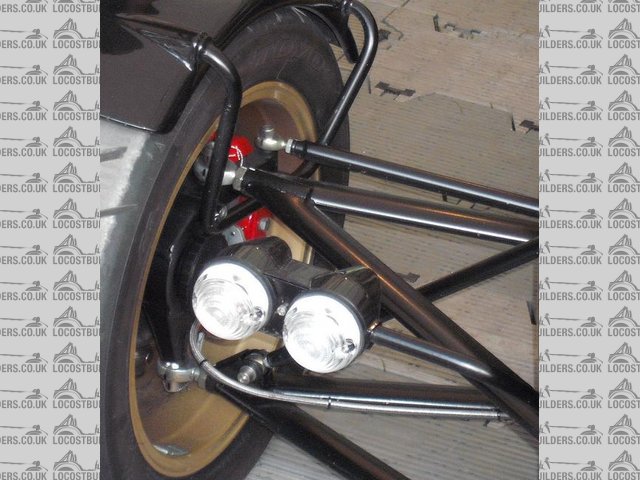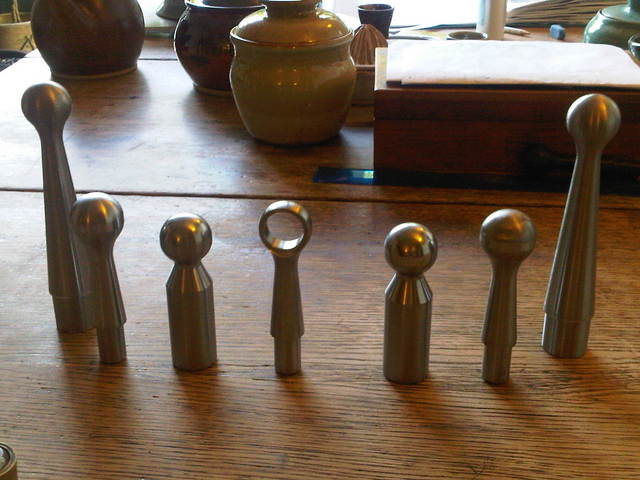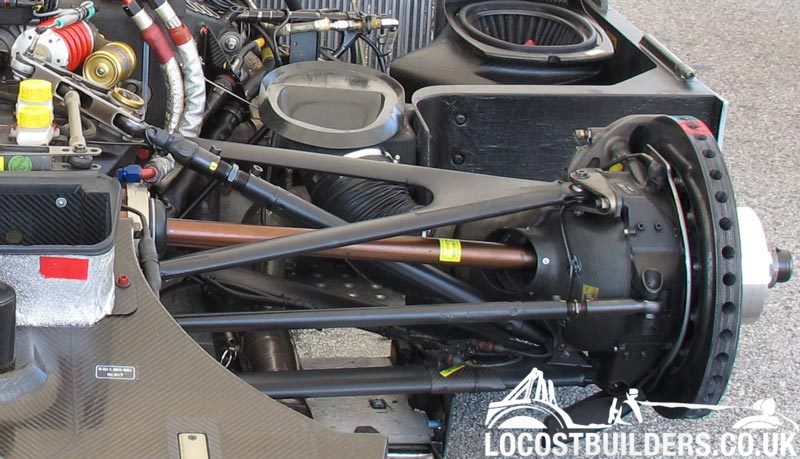
Oh the horror!
Doug68 - 10/7/11 at 02:53 AM
Not wanting to hijack Itsu sans build thread...
With respect to rod ends in bending.
Here's a couple of examples of things being done "wrong". Now I don't pretend to say that they're "right".
Just rather, metal doesn't care about opinions, but it does behave according to the math, so just because these cars made it work, doesn't
mean automatically its fine for you, neither on the other hand does it mean instant death by going down this path.
The one thing that I would point out is that on all the cars shown the rod end is much bigger than you might expect.
Early 1970's Ferrari...

Real Porshe 908 rear...

1985(?) Argo IMSA car was once rotary powered and now Cosworth powered...


coyoteboy - 10/7/11 at 03:55 PM
Look at the shank diameters, they're fecking huge!
Doug68 - 10/7/11 at 11:39 PM
Yep. I guess someone did their maths 
Neville Jones - 11/7/11 at 10:37 AM
Those pics are very dated, as is the vehicle. These days, the wishbones would be made in one piece, with sphericals in turned housings in the ends.
The thickness of the shanks is still very relevant though, if youintend to go down this route.
Cheers,
Nev.
onenastyviper - 11/7/11 at 12:30 PM
I have read somewhere (can't remember where but it has stuck in my head) that the use of rod-ends in bending is acceptable but only as a
temporary measure to determine the desired geometry then final wishbones are manufactured with spherical used.
So my question is are the wishbones available with correct geometry for the locost and sphericals used instead of rod-ends in bending?
Neville Jones - 11/7/11 at 08:40 PM
quote:
Originally posted by onenastyviper
I have read somewhere (can't remember where but it has stuck in my head) that the use of rod-ends in bending is acceptable but only as a
temporary measure to determine the desired geometry then final wishbones are manufactured with spherical used.
So my question is are the wishbones available with correct geometry for the locost and sphericals used instead of rod-ends in bending?
Depends who you talk to. 
I know a man who's been known to make and design them, on occasion. 
Cheers,
nev.
Litemoth - 11/7/11 at 09:02 PM
I can't see what's wrong....educate me?
None of the rose joints are in bending as far as i can see. The strut is attached to the bottom wishbone and i can't see that it doesn't
have a ball joint at that point it joins the hub carrier?
[Edited on 11/7/11 by Litemoth]
JC - 11/7/11 at 09:04 PM
There was a Formula Student article posted on here some time ago, said words to the effect that Rod ends in bending were not a problem per se,
providing they were big enough. However, if they were big enough, they would be heavier than necessary therefore bad engineering and loose points!
The 'correct' use was to use them to determine settings, then replace with spherical bearings.
After all that, I'm using them on the back of my car! 
Rod Ends - 11/7/11 at 10:17 PM
Ariel Atom V8 wishbones & upright


Description
Doug68 - 12/7/11 at 02:15 AM
quote:
Originally posted by Litemoth
I can't see what's wrong....educate me?
None of the rose joints are in bending as far as i can see. The strut is attached to the bottom wishbone and i can't see that it doesn't
have a ball joint at that point it joins the hub carrier?
[Edited on 11/7/11 by Litemoth]
When the wheel has torque being put through it either through braking or drive then the upright has to take the reaction to that torque, so
essentially the rod end is trying to be forced to the front or to the back of the car.
The bending load then relates to the overhang from where the rod end comes out of the A arm to the centre of the rod end.
Grimsdale - 12/7/11 at 07:39 AM
how is that different to the transit top ball joints used on many cars? Just that the transit ones are larger diameter?
I have managed to slightly bend a set of ball joints, but that was only on hitting a toyota!
MikeRJ - 12/7/11 at 08:38 AM
It's no different to the transit drag link ends - they are also being "abused" in the same way on locosts and westfields etc. though
they do have pretty hefty shanks and failures seem to be very rare.
bi22le - 12/7/11 at 09:51 AM
If your car had this already and you was worried i would set up the rose joints then sleeve with a piece of suitable thick wall tube. we use this
method at work often and makes it really as strong as a piece of solid bar, weighs about the same too!!
Solves the problem though if there is one!!ably sized
onenastyviper - 12/7/11 at 12:19 PM
I suppose it is an issue of perspective in design optimisation: do you settle for rod-ends in bending or do you go that extra step, refine the design
and end up with a more elegant solution?
This is all fascinating.
quote:
Originally posted by bi22le
If your car had this already and you was worried i would set up the rose joints then sleeve with a piece of suitable thick wall tube. we use this
method at work often and makes it really as strong as a piece of solid bar, weighs about the same too!!
Solves the problem though if there is one!!ably sized
mookaloid - 12/7/11 at 12:51 PM
quote:
Originally posted by Rod Ends
Ariel Atom V8 wishbones & upright


Description
In my opinion in this picture the bottom ball joint is not suitable for this application There are much greater bending forces than on the top and the
steering joints because the suspension (spring) mounting is bearing on it. This would create a potential fatigue fracture where the threads on the rod
shank create a natural starting point for a crack to form.
Doug68 - 12/7/11 at 02:24 PM
In my opinion in this picture the bottom ball joint is not suitable for this application
Ah but can you prove it? Opinions don't make parts fail.
I agree with you BTW I would not have done it either, but it's only really "wrong" if it fails isn't? Maybe it could be
"better" but that's a subjective argument as well.
The issue probably lies somewhere down the road when an owner substitutes a low spec part to save a few $ replacing a knackered bearing then lo an
behold the wheel falls off.
Neville Jones - 12/7/11 at 07:15 PM
In my opinion in this picture the bottom ball joint is not suitable for this application
I think you'll find that the yanks aren't allowed/don't use the Ariel factory lower wishbones, specifically for the reason that they
had failures.
Cheers,
Nev.
ceebmoj - 14/7/11 at 12:28 AM
quote:
Originally posted by mookaloid
quote:
Originally posted by Rod Ends
Ariel Atom V8 wishbones & upright


Description
In my opinion in this picture the bottom ball joint is not suitable for this application There are much greater bending forces than on the top and the
steering joints because the suspension (spring) mounting is bearing on it. This would create a potential fatigue fracture where the threads on the rod
shank create a natural starting point for a crack to form.
Has any one got any pictures of how it should be done?
Theshed - 14/7/11 at 05:55 AM
I do not say that this is the way "it should be done" but I am in the very slow process of making wishbones without side loaded threads. In
the picture the finished parts (with holes in their hears) are for the inner top joints and the unfinished short fat ones are for the outer top.


Various wishbone bits
Benonymous - 15/7/11 at 06:41 AM
I recall an engineer friend saying to me once how cutting a thread on a rod decreases it's strength significantly. If you put a coarse metric
thread on a rod, you reduce its effective diameter by one millimeter but the act of cutting the thread and the stresses it produces make the real
reduction in strength more than just reducing the diameter by one millimeter. I'm sure that this mainly refers to cut threads and not rolled
ones, I think rolled threads are significanltly less problematic where it comes to stresses.
mookaloid - 15/7/11 at 09:48 AM
quote:
Originally posted by Doug68
In my opinion in this picture the bottom ball joint is not suitable for this application
Ah but can you prove it? Opinions don't make parts fail.
Can't prove it - but on the basis that if it looks wrong it probably is wrong then it's probably wrong. I did mechanical engineering at
university many years ago. this principle was drummed into us and it hasn't let me down so far.
Cheers
Mark
mookaloid - 15/7/11 at 10:00 AM
quote:
Originally posted by Benonymous
I recall an engineer friend saying to me once how cutting a thread on a rod decreases it's strength significantly. If you put a coarse metric
thread on a rod, you reduce its effective diameter by one millimeter but the act of cutting the thread and the stresses it produces make the real
reduction in strength more than just reducing the diameter by one millimeter. I'm sure that this mainly refers to cut threads and not rolled
ones, I think rolled threads are significanltly less problematic where it comes to stresses.
the real problem is not that it makes the rod thinner:
if you imagine a straight bar (no thread) which is the same diameter as the reduced (effective) diameter of a threaded rod, then bend them both
repeatedly the same number of times and over the same deflection, then the threaded one will fail first because the stresses of bending are
concentrated at the bottom of the thread V and a crack will start to form much quicker where the threads have caused a concentrated area of stress.
The rolled threads may have a more U shaped thread which might account for them being slightly less vulnerable to this. however they are still weaker
than the plain bar.
mookaloid - 15/7/11 at 10:02 AM
quote:
Originally posted by ceebmoj
quote:
Originally posted by mookaloid
quote:
Originally posted by Rod Ends
Ariel Atom V8 wishbones & upright


Description
In my opinion in this picture the bottom ball joint is not suitable for this application There are much greater bending forces than on the top and the
steering joints because the suspension (spring) mounting is bearing on it. This would create a potential fatigue fracture where the threads on the rod
shank create a natural starting point for a crack to form.
Has any one got any pictures of how it should be done?
Have a look at the bottom ball joint on an MK Indy as an example.
Doug68 - 18/7/11 at 03:17 PM
Audi R8...


thomas4age - 5/11/11 at 09:08 PM
Old thread perhaps,
But, the audi ones are minebea, which is the same GD uses on their T70 cars, not cheap but very very VERY strong. look into those when dealing with
higher weight or performance cars. I asked Andy burrows wheter it would be more cost effectie to put something cheaper in it awnser was "yes, but
I wouldn't drive it" nuff said realy.
grtz Thomas
coyoteboy - 16/11/11 at 02:59 PM
The Audi has done it correctly, there are no rod ends in that other than the toe link and that's not in bending.












